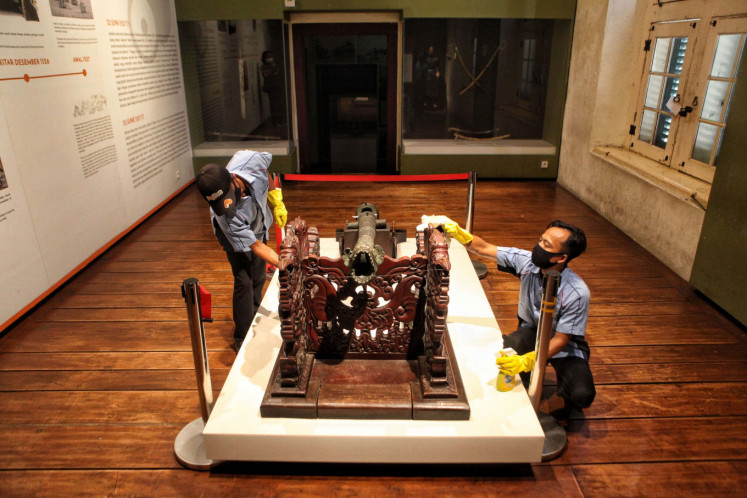Prince Diponegoro’s kris cuts to the core of Indonesian identity
Heritage: The Kyai Naga Siluman kris belonged to Prince Diponegoro
Change text size
Gift Premium Articles
to Anyone

Heritage: The Kyai Naga Siluman kris belonged to Prince Diponegoro.(Antara/Hanni Sofia)
The government hopes the Dutch government’s return of a gold-inlaid kris belonging to Prince Diponegoro on March 3 will encourage the repatriation of more cultural artefacts from Indonesia’s former colonizer in the future.
Prince Diponogoro — who was the eldest son of the Yogyakartan Sultan Hamengkubuwono III — played a key role in early struggles for Indonesian independence. He led a five-year campaign against Dutch colonial rule that ended with his arrest on March 28, 1830, and his subsequent exile.
The kris was on display as President Joko “Jokowi” Widodo hosted Dutch King Willem-Alexander and Queen Maxima at Bogor Palace, West Java, on Tuesday.
Education and Culture Ministry cultural director general Hilmar Farid, who led the repatriation effort for the kris, said the Indonesian and Dutch governments were on the same page regarding the repatriation of cultural artifacts that were forcibly obtained by the Dutch during their colonial rule over the archipelago.
“When we observed the kris together, the king said it belonged here [in Indonesia],” said Hilmar. “So the Dutch government is on the same page regarding historical objects that were not handed over voluntarily, either by war or by seizure.”
Agreements have been in place since 1975 that provide the legal framework for Indonesia to request the repatriation of cultural items that were forcibly taken during colonial times, Hilmar said.
He added that teams from Indonesia and the Netherlands will convene in Indonesia in July of this year to discuss the details of the repatriation plans, adding that the government would focus on "culturally significant" items in future repatriation efforts.
“We will focus on [artifacts] that have high symbolic value. The kris has a significant symbolic value to the general public. We will focus on that kind of object,” said Hilmar.
Efforts for the repatriation of the kris began in 1984. The dagger is now undergoing conservation and will be on public display at the National Museum in Jakarta on April, said Hilmar.
Indonesia previously welcomed 1,500 artifacts from the Nusantara Museum in Delft, which specifically dedicated its collection to art and cultural objects from Indonesia and closed in 2013 due to financial difficulties. The objects were given to the National Museum in Indonesia. The repatriation effort symbolically started in November 2016.
Sri Margana, a historian from Gadjah Mada University who participated in the kris’ repatriation, told The Jakarta Post on Wednesday that cultural items from the past were very important to complete the narrative of the Indonesian identity.

“The items are historically important to reinforce the identity of Indonesia,” said Sri. “There are many [parts of] Indonesian history that could not be completed because of the lack of historical evidence.”
The kris was the fourth item connected with Prince Diponegoro to be returned to Indonesia. The government previously welcomed back the prince’s cane and saddle in 1978 as well as the prince’s spear in 2015.
Sri, who joined the kris’ research team in 2017, said the delay before each item’s return to Indonesia was primarily a result of the extensive research that needed to be undertaken to identify the objects.
Sanata Dharma University historian Heri Priyatmoko said the return of the Prince Diponegoro’s kris could be a sign of Dutch trust that Indonesia could protect the historical artifact.
"This could also increase public interest in maintaining our cultural heritage and learning more about our history, especially about Prince Diponegoro," he said.
He added that the Kris was emblematic of Indonesia's resistance to Dutch colonialism as the weapon signified the country's deftness at crafting traditional weaponry for war, social status and decoration.
Titok Hariyanto, a kris fanatic, was also grateful that the traditional weapon was returned, even though further examination was necessary to determine whether it was the real Naga Siluman kris owned by Prince Diponegoro.
"Legitimacy issues aside, the heirloom kris can be seen as a reminder that our ancestors have a strong zeal for independence in the true sense," he said. (mfp)









